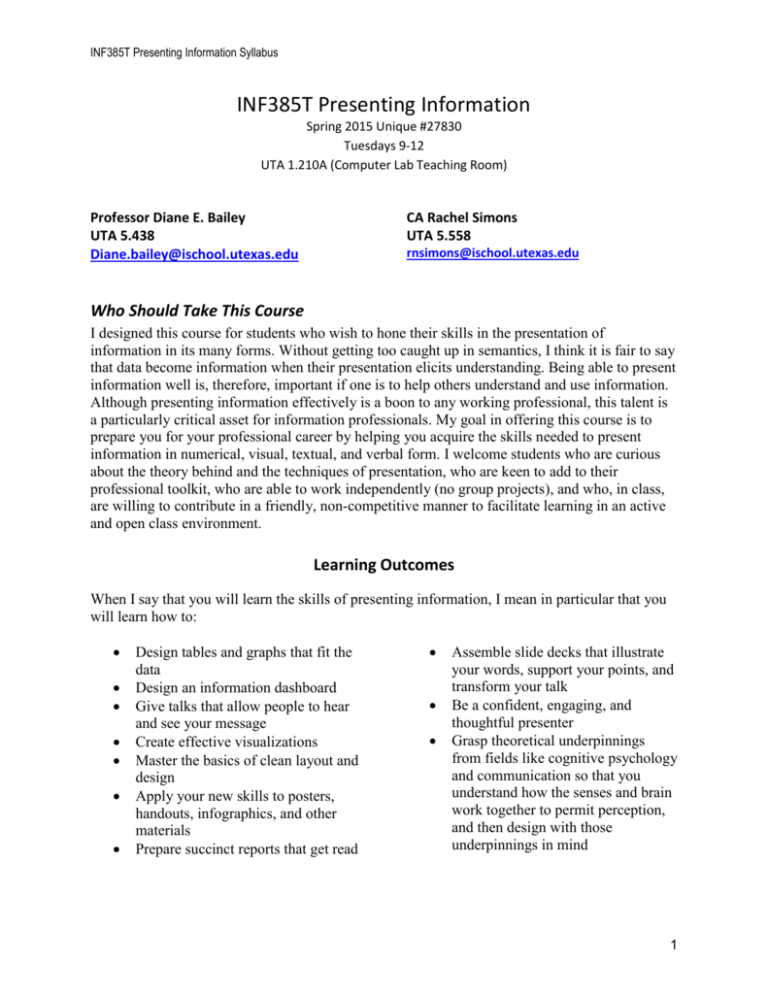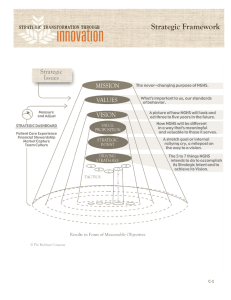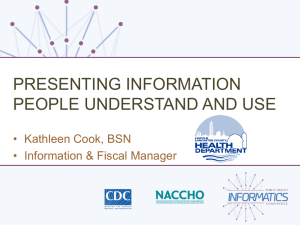Spring 2015 Unique #27830 - School of Information
advertisement

INF385T Presenting Information Syllabus INF385T Presenting Information Spring 2015 Unique #27830 Tuesdays 9-12 UTA 1.210A (Computer Lab Teaching Room) Professor Diane E. Bailey UTA 5.438 Diane.bailey@ischool.utexas.edu CA Rachel Simons UTA 5.558 rnsimons@ischool.utexas.edu Who Should Take This Course I designed this course for students who wish to hone their skills in the presentation of information in its many forms. Without getting too caught up in semantics, I think it is fair to say that data become information when their presentation elicits understanding. Being able to present information well is, therefore, important if one is to help others understand and use information. Although presenting information effectively is a boon to any working professional, this talent is a particularly critical asset for information professionals. My goal in offering this course is to prepare you for your professional career by helping you acquire the skills needed to present information in numerical, visual, textual, and verbal form. I welcome students who are curious about the theory behind and the techniques of presentation, who are keen to add to their professional toolkit, who are able to work independently (no group projects), and who, in class, are willing to contribute in a friendly, non-competitive manner to facilitate learning in an active and open class environment. Learning Outcomes When I say that you will learn the skills of presenting information, I mean in particular that you will learn how to: Design tables and graphs that fit the data Design an information dashboard Give talks that allow people to hear and see your message Create effective visualizations Master the basics of clean layout and design Apply your new skills to posters, handouts, infographics, and other materials Prepare succinct reports that get read Assemble slide decks that illustrate your words, support your points, and transform your talk Be a confident, engaging, and thoughtful presenter Grasp theoretical underpinnings from fields like cognitive psychology and communication so that you understand how the senses and brain work together to permit perception, and then design with those underpinnings in mind 1 INF385T Presenting Information Syllabus Overview Bad information design confronts us every day. Posters and flyers force us to hunt for basic information of where, when, who, what, and why. Emails ramble, address too many topics, and bury requests at the bottom. Reports lack clear formatting that would help us find information quickly; graphics appear in reports with no explanatory text or titles. We see newsletters with vague content and hear talks that meander with no clear point. Slide decks inundate us with bulleted lists and animation. Whether the presentation is numerical, visual, textual, or verbal, bad design choices hinder our ability to comprehend and use information. As information professionals, we, of all people, ought to know better. This course is one attempt to make sure we do. But mostly, it is an opportunity for us to have fun exploring new areas while learning how to be good presenters of information. That is to say, if you think you’ll like learning why white space is our friend, why tables look better with shading than with grid lines, why a three-panel layout is a winner every time, and why “tell them where you’re going, tell them where you are, tell them where you’ve been” is a bit tired as a plan for talk outlines, this course is for you. Although our time together will be slanted towards gaining practical skills, we will build up these skills on the basis of our understanding of fundamental theories in areas such as cognitive psychology and communication that explain how people perceive and construe sensory input. Course Policies Attendance and Participation You are expected to attend every class and to have completed the reading and any assignments so that you can actively engage in discussions. Your attendance and participation in class, including your willingness to discuss topics and your helpful, genuine behavior towards your classmates, may affect your grade at my discretion. Grading Let’s begin with the understanding that I expect you to give each assignment your best effort; you simply cannot gain these skills if you don’t put in the time. To help you focus on gaining skills, not grades, three of your assignments are pass/fail (P/F), meaning that if you do the minimum that I ask, you will get full credit. P/F assignments are particularly helpful in cases in which you will be gaining a skill step by step. Thus, for example, you will give three talks, but the first one is P/F because talks are stressful; I want you to begin your learning without the added worry of a grade. Similarly, the tables and graphs assignment is a prelude to your dashboard, and your two pages of text will help you develop skills as you build towards your report; thus, these assignments are P/F. I describe all assignments later in this syllabus. Tables and Graphs Dashboard and Description Talk I Poster, Newsletter, or Brochure Two Pages of Text 5% (P/F) 25% 5% (P/F) 10% 5% (P/F) Slide Deck Talk II Written Report Talk III Infographic Total 15% 5% 10% 10% 10% 100% 2 INF385T Presenting Information Syllabus Late Work Policy I think that meeting deadlines is good preparation for a professional career. Thus, you will lose half a letter grade if your materials are not ready by the beginning of class on their due date. You will lose another half a grade per additional weekday late. When handing in your work, please do not tell me that your work is late or constructed inappropriately because a printer was not working, the software failed that morning, or you could not find a stapler. After all, the entire point of this course is the professional presentation of information, so be professional. University of Texas Honor Code The core values of The University of Texas at Austin are learning, discovery, freedom, leadership, individual opportunity, and responsibility. Each member of the university is expected to uphold these values through integrity, honesty, trust, fairness, and respect toward peers and community. Source: http://www.utexas.edu/welcome/mission.html Documented Disability Statement Any student with a documented disability who requires academic accommodations should contact Services for Students with Disabilities (SSD) at (512) 471-6259 (voice) or 1-866-3293986 (video phone). Faculty are not required to provide accommodations without an official accommodation letter from SSD. Please notify me as quickly as possible if the material being presented in class is not accessible (e.g., instructional videos need captioning, course packets are not readable for proper alternative text conversion, etc.). Please notify me as early in the semester as possible if disability-related accommodations for field trips are required. Advanced notice will permit the arrangement of accommodations on the given day (e.g., transportation, site accessibility, etc.). Contact Services for Students with Disabilities at 471-6259 (voice) or 1-866-329-3986 (video phone) or reference SSD’s website for more disability-related information: http://www.utexas.edu/diversity/ddce/ssd/for_cstudents.php Assignments There are no group assignments in this class. My sense is that you do plenty of group projects in our program, and I want each of you to gain all the skills in this class, not rely on someone else for them. Therefore, I expect you to hand in assignments that reflect what you have learned and your individual effort, not others’ effort. I encourage you, however, to seek your peers’ help, advice, and feedback. For example, your peers may show you a software trick to solve a problem you cannot resolve on your own or they may critique your design and offer ideas to improve it. In short, I want to free you from the binds of collaboration and coordination that group assignments typically entail while allowing you to learn from and with each other. Tables and Graphs. Due Week 5 – Feb 17 You will be given a handout in class week 3 with instructions for designing a set of tables and graphs. This assignment involves the creation of three items. You will hand in by email to me before class two of the items: a revised Excel spreadsheet and a slide deck (.ppt, .pptx, or .pdf). There is no reason that either of these items should exceed 1 MB in size. If yours exceed that 3 INF385T Presenting Information Syllabus size, seek help from the purple shirts to reduce them before sending to me; do not send me large files. You will also hand in a third text-based item (printed out, stapled, and brought to class). See the handout for details of what I require for each item. In terms of grading, this assignment is P/F: If I determine that you have exerted effort in good faith (e.g., you did what I asked, your design was thoughtful), you will get full points; else you will receive no points. Dashboard and Dashboard Written Description. Due Week 8 – Mar 10 You will design an information dashboard for an organization of your choice. The organization must be real and cannot be a company that you are thinking of starting. The organization must agree to your plan to build a dashboard for them and should be willing to provide you with the necessary information to do so. To convince an organization that they could use a dashboard for internal or external use, you might show them some examples; just type “information dashboard” into Google images, or direct them to this one at a museum: http://dashboard.imamuseum.org/. You are responsible only for the front end design of the dashboard, not the back end programming that would fetch and deposit information. You will hand in the dashboard design as a digital file by email to me before class (as a .pdf exported from dashboard software) with a written description (printed out, stapled, and brought to class) of its details: what information it displays, why the dashboard displays information the way it does, and why the dashboard includes the information that it does (for example, what the information’s relevance to the organization is). Your description will begin with a one-paragraph description of the organization. You should include in your description a brief discussion of information that you considered for, but chose not to include on, the dashboard. I will grade your work based on how well you address each of the items above in your written description in addition to the quality of the dashboard itself. I will judge dashboard quality according to the readability of its components, the sense that a viewer can readily make of it, the perceived value that the organization would gain from it, the perceived appropriateness of the quantity and type of information that you display, and your attention to detail. I will not grade the description as a report in its own right (as a written presentation of information) because at this stage we will not yet have covered those skills. Nonetheless, a clear, logical description free of grammatical and typographical errors will aid your cause. I expect the written description (not counting the printed dashboard) to be at least three pages long and typically not more than five. Talk I. Due Week 8 – Mar 10 You will give a talk in which you treat the class as an audience from the organization for which you designed the dashboard. Your talk will be the “reveal” of the dashboard, in which you will lay out for the organization many of the same points you included in your dashboard written description. In addition, you will want to convey to your audience how they should use the dashboard. You will not use slides or a projector for this talk. Instead, you should print your dashboard on posterboard (20x30 preferred), which we will display on a stand during your talk. I will provide the stand; you will provide the posterboard. For tips on printing your posterboard, see https://tutorials.ischool.utexas.edu/index.php/Poster_Design_%26_Printing_Resources. In terms of grading, this talk is P/F, which means if you make an attempt that I deem conscientious (e.g., you are prepared and clearly have practiced), you will get full points, else you will get zero points. In other words, this talk is your chance to get down basic skills without the added anxiety 4 INF385T Presenting Information Syllabus of graded assessment. You will receive feedback from the class and me that will highlight what you did well and where you can improve. See the form at the end of this syllabus for the performance areas on which we will comment. Class size will determine talk length, but a reasonable ballpark figure for now is 3 minutes. Poster, Brochure, or Newsletter. Due Week 10 – Mar 31 At the beginning of the design workshop in week 9, I will present you with a choice: You will create a poster, a newsletter, or a brochure per my in-class specifications. (I have a set of organizations that have submitted design problems of these types.) You will submit your creation as a digital file by email to me before class that I can read without special software (e.g., .pdf or an image file like .jpg or .png). I will grade the designs according to the quality of your application of layout and design principles that we will have discussed in class, such as your use of white space, font type, placement, and so on. Slide Deck. Due Week 12 – Apr 14 You will create a slide deck for an organization of your choice. The organization must be real and cannot be a company that you are thinking of starting, but in this case they need not know about or approve your intentions. In other words, you may fabricate the data in your slides if you like, although real data is always more interesting and meaningful. You must have at least five slides in the deck, with no two slides exactly alike in format or content. The deck can be a deck that an organization gave to you and asked you to fix up or it can be a deck that you create from scratch. You will submit your deck by email to me before class as a digital file (either as .ppt, .pptx, or .pdf). Ask the purple shirts for help if your file exceeds 5 MB; in other words, do not send me anything bigger than that. In terms of grading, I want to see you display a range of information that demands a range of presentation formats (e.g., text, charts, graphics, and photos), yet forms a coherent set. I will further grade the designs according to the quality of your application of layout and design principles that we will have discussed in class, such as your use of white space, font type, placement, and so on, in addition to principles tailored to slide decks, such as font size, use of bullets, and color combinations. Talk II. Due Week 12 – Apr 14 You will give a talk using your slide deck. You will not give a talk that explains your design choices in relation to the slide deck (as you did for the dashboard); rather, you will give the talk that a person from the organization might give with the slide deck. You will construe the class as the audience appropriate for that talk. Class size will determine talk length, but a reasonable ballpark figure for now is 3 minutes. I will grade the talk against criteria that we will discuss in class and that appear on the evaluation form at the end of this syllabus. You will receive feedback from the class and me that will highlight what you did well and where you can improve according to the performance aspects outlined in the evaluation form. Two Pages of Text. Due Week 13 – Apr 21 For a class writing exercise, you must bring to class in hard copy form (printed out) the first two pages, and two pages only, of a paper that you wrote for some other class, either here in the iSchool or elsewhere. Do not alter the text in any way from its original submission other than to 5 INF385T Presenting Information Syllabus ensure that it is double-spaced and 12 point font. You gain full points simply for timely submission of two full pages; failure to submit earns zero points. Infographic. Due Week 15 – May 5 You will create an infographic for an organization of your choice. The organization must be real and cannot be a company that you are thinking of starting, but in this case they need not know about or approve your intentions. In other words, you may fabricate the data behind your infographic if you like, although real data is always more interesting and meaningful. You will hand in the infographic by email to me before class as a digital file that I can read without special software (e.g., .pdf or as an image file like .jpg or .png). Ask the purple shirts for help if your file exceeds 5 MB; in other words, do not send me anything bigger than that. I will grade your infographic according to the readability of its components, the sense that a viewer can readily make of it, the perceived value that the organization would gain from it, the perceived appropriateness of the quantity and type of information that you display, your attention to detail, and your application of layout and design principles as we will have discussed in this class. Written Report. Due Week 15 – May 5 You will create a report detailing for your organization the features of their new infographic. As part of your report, you will spell out the research that you did about the organization, its mission, and its needs and how that information shaped your design. You will explain why you included the content that you did, and why you rejected some other possibilities. You will note the objective of the infographic. You should not provide a play-by-play of your thought processes or design decisions, but you should make clear why the infographics has the form and content that it does. You should highlight the features of infographic and note how the organization might employ it. The first page of the report should be a cover page containing, at a minimum, the report title, your name, the date submitted, and the organization’s name. The report should begin with an executive summary labeled as such and no longer than one page, followed by a table of contents. We will discuss in class how to craft executive summaries and tables of content. Following the table of contents should be a list of figures and a list of tables. The balance of the report should feature orderly sections with subheadings. Use graphics such as tables and figures, all neatly titled and labeled, to help convey data-rich information. This information may have informed your design, may be part of it, or may be information that you considered for inclusion but ultimately rejected. You must include at least one table and one chart. There is no page limit for this report; you should balance brevity with necessary detail. There are no requirements for line spacing or font size, but your report must have minimum oneinch margins. Bring a printed copy of your report to class; do not email it to me. Staple your report, and, if possible, print it double-sided. A plastic cover or any binding other than a staple is not acceptable. 6 INF385T Presenting Information Syllabus I will grade your report based on solid writing, logical organization, coherent presentation, quality of content, good design (including recognition of design principles), and conformity to the specifications detailed here. Talk III. Due Week 15 – May 5 In this talk, you will address, as the designer, the organization for which you have designed an infographic. You will explain to them your design and your rationale for it, raising points similar to those that you included in your written report. Class size will determine talk length, but a reasonable ballpark figure at this time is 3 minutes. You may use any display technology you like, although in the past a slide projection seems to have worked better than a posterboard of your infographic because of the ability to zoom for all to see. I will grade the talk against criteria that we will discuss in class and that appear on the evaluation form at the end of this syllabus. You will receive feedback from the class and me that will highlight what you did well and where you can improve according to the performance aspects outlined in the evaluation form. Materials Required Physical Implements (bring the first three to class every day) 1. Calculator. 2. Wooden (preferred) or rigid plastic ruler. 3. Blank unlined paper or a sketch pad of full page size, plus a pencil. 4. Posterboard for dashboard assignment, 20”x30”. 5. Spraymount (buddy up with 2-3 friends to split a bottle, good for ~4 posterboards). Required Books (bring to class on appropriate day) 1. Few, Stephen. 2006. Information Dashboard Design: The Effective Visual Communication of Data. Sebastopol, CA: O’Reilly Media. 2. Golombisky, Kim and Hagen, Rebecca. 2010. White Space is Not Your Enemy: A Beginner’s Guide to Communicating Visually through Graphic, Web, & Multimedia Design. Burlington, MA: Elsevier. 3. Reynolds, Garr. 2008. Presentation Zen: Simple Ideas on Presentation Design and Delivery. Berkeley, CA: New Riders. 4. Roman, K. and Raphaelson, J. 2000. Writing that Works: How to Communicate Effectively in Business, 3rd Edition. Collins. 5. A grammar book of your choice. There are many good ones out there. Here’s a favorite of mine: Thurman, Susan. 2003. The Only Grammar Book You’ll Ever Need: A One-Stop Source for Every Writing Assignment. Avon, Mass.: Adams Media. Required Articles and Book Chapters (on Canvas) 1. Behn, Robert D. 2012. The craft of memo writing. Self-published on the web from Harvard’s Kennedy School: http://www.hks.harvard.edu/thebehnreport/All%20Issues/Behn,%20Craft%20of%20Mem o%20Writing%202012.pdf 2. Cleveland, William S. 1984. Graphs in scientific publications. The American Statistician, 38(4): 261-269. 3. Cleveland, William S. and McGill, Robert. 1985. Graphical perception and graphical methods for analyzing scientific data. Science, 229(4716): 828-833. 7 INF385T Presenting Information Syllabus 4. Grant, Elizabeth R. and Spivey, Michael J. 2003. Eye movements and problem solving: Guiding attention guides thought. Psychological Science, 14(5): 462- 466. 5. Heath, C. & Heath, D. 2008. Making your presentation stick. From their website: http://heathbrothers.com/resources/. 6. Hegarty, Mary. 2011. The cognitive science of visual-spatial displays: Implications for design. Topics in Cognitive Science, 3:446-474. 7. Kosslyn, Stephen M. 1989. Understanding charts and graphs. 1989. Applied Cognitive Psychology, 3:185-226. 8. McCabe, David P. and Catel, Alan D. 2008. Seeing is believing: The effect of brain images on judgments of scientific reasoning. Cognition, 107: 343-352. 9. Savoy, April, Proctor, Robert W., and Salvendy, Gavriel. 2009. Information retention from PowerPointTM and traditional lectures. Computers & Education, 52: 858-867. 10. Scaife, Mike and Rogers, Yvonne. 1996. External cognition: How do graphical representations work? International Journal of Human-Computer Studies, 45: 185-213. 11. Schwabish, Jonathan A. 2012. Infographics at the Congressional Budget Office. IEEE Conference on Visual Analytics Science and Technology, Seattle, WA, 141-142. 12. Smith, Laurence D., Best, Lisa A., Stubbs, D. Alan, Archibald, Andrea Bastiani, and Robertson-Nay, Roxann. 2002. Constructing knowledge: The role of graphs and tables in hard and soft psychology. American Psychologist, 57(10): 749-761. Handy Books (not required, but useful in everyday work) 1. Cairo, Alberto. 2013. The Functional Art: An Introduction to Information Graphics and Visualization. Berkeley, CA: New Riders. 2. Few, Stephen. 2004. Show Me the Numbers: Designing Tables and Graphs to Enlighten. Oakland, CA: Analytics Press. 3. Kosslyn, Stephen M. 2006. Graph Design for the Eye and Mind. Oxford University Press. 4. Murray, Daniel G. 2013. Tableau Your Data: Fast and Easy Visual Analysis with Tableau Software®. Indianapolis, IN: John Wiley & Sons. 5. White, Alex W. 2011. The Elements of Graphic Design, Second Ed. NY: Allworth Press. 6. Williams, Robin. 1995. The PC is Not a Typewriter. San Francisco, CA: Peachpit Press. (or the similarly titled Mac book) 7. Wong, Dona M. 2010. The Wall Street Journal Guide to Information Graphics: The Do’s and Don’ts of Presenting Data, Facts, and Figures. New York, NY: W.W. Norton. Informative Books (not required, but useful in gaining scientific knowledge) 1. Changizi, Mark. 2009. The Vision Revolution: How the Latest Research Overturns Everything We Thought We Knew About Human Vision. Dallas, TX: Benbella Books. 2. Gregory, Richard L. 1997. Eye and Brain: The Psychology of Seeing, Fifth Ed. Princeton, NJ: Princeton University Press. 3. Hoffman, Donald D. 1998. Visual Intelligence: How We Create What We See. New York: W.W. Norton & Company. 4. Ware, Colin. 2013. Information Visualization: Perception for Design, Third Ed. Waltham, MA: Morgan Kaufmann. 5. Ware, Colin. 2008. Visual Thinking for Design. Burlington, MA: Morgan Kaufmann. 8 INF385T Presenting Information Syllabus Fascinating Books (not required, but intriguing and helpful in developing understanding) 1. Frankel, Felice C., and DePace, Angela H. 2012. Visual Strategies: A Practical Guide to Graphics for Scientists & Engineers. Yale University Press: New Haven. 2. Meirelles, Isable. 2013. Design for Information: An Introduction to the Histories, Theories, and Best Practices behind Effective Information Visualizations. Beverley, MA: Rockport Publishers. 3. Tufte, Edward R. 2001. The Visual Display of Quantitative Information. Cheshire, CT: Graphics Press. 4. Tufte, Edward R. 1990. Envisioning Information. Cheshire, CT: Graphics Press. 9 INF385T Presenting Information Syllabus Course Schedule Wk Topic 1 Intro to class, plus 1/20 Excel workshop Reading and Other Preparation (to be done BEFORE class) Read Cleveland, “Graphs in Scientific Publications” Read Grant and Spivey, 2003, “Eye Movements and Problem Solving” Read McCabe and Castel, 2008, “The Effect of Brain Images on Judgments of Scientific Reasoning” 2 Graphical practice 1/27 and integrity Read Hegarty, 2011, “Visual-Spatial Displays” Read Scaife and Rogers, 1996, “How Do Graphical Representations In-Class Activity Student intros Working with data, tables, and charts in Excel Due (in class) Measuring Work?” 3 2/3 Tables Read Smith et al., 2002, “The Role of Graphs and Tables in Hard and Soft Psychology” 4 Graphs 2/10 Read Kosslyn, “Understanding Charts and Graphs” Read Cleveland and McGill, “Graphical Perception” 5 Dashboards I 2/17 Read Few, Information Dashboard Design, Ch. 1-4. 6 Dashboards II 2/24 Read Few, Information Dashboard Design, Ch. 5-8 7 3/3 Read Heath & Heath, “Making Your Presentation Stick” Read Roman & Raphaelson, Writing that Works, Ch. 6. Watch one talk on TED: http://www.ted.com/. Analyze it. How did the Talks Table workshop HW handout Graph workshop Tables and Graphs Dashboards workshop speaker open? How did she frame her story? What visuals did she use? How did she use her body to aid her talk? 8 Talks - I 3/10 Student talks Dashboard 10 INF385T Presenting Information Syllabus Wk Topic Reading and Other Preparation (to be done BEFORE class) In-Class Activity Due (in class) Spring Break (week of 3/17) 9 Layouts 3/24 Read Golombisky & Hagen, White Space Design workshop 10 Slide Decks 3/31 Read Reynolds, Presentation Zen. Read Savoy et. al., “Information Retention from PowerPoint” Slide workshop Poster, Brochure, or Newsletter 11 4/7 Read Schwabish, 2012, “Infographics at the Congressional Budget Student talks Slide Deck Grammar-a-thon Writing workshop Two pages of text Student talks Infographic and Report Infographics and Data Visualization Office” 12 Talks – II 4/14 13 Writing Basics 4/21 Read your grammar book. Completely. Twice. For me. Please. 14 Report Basics: 4/28 Putting it All Together Read Roman & Raphaelson, Writing that Works, Ch. 1-3, 7, 12-13 15 5/5 Talks – III 11 INF385T Presenting Information Syllabus Talk Evaluation Presenter’s Name ___________________________________ Performance Aspects of the Talk (areas about which the class might comment) Cognitive Aspects of Presentation Strong Introduction Compelling Narrative Logical Roadmap Clarity of Main Points Number of Main Points Strong Conclusion Handling of Q&A Sense of Planning and Strategy Seeming Knowledge of Audience Engaging or Useful Content Physical and Affective Aspects of Presentation Pace of Speaking Volume Use of Silence or Pauses Eye Contact Body Posture and Stillness Connection to Audience Ease Friendliness Visual Aids What you did well: Where you might improve a bit (one or two areas): About that visual aid in particular (how well it worked for you, what you might have done differently): 12







